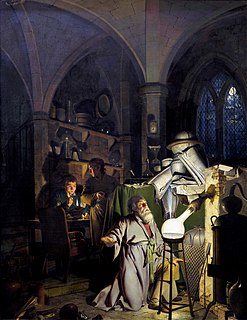 W
WThe Alchemist Discovering Phosphorus is a painting by Joseph Wright of Derby originally completed in 1771 then reworked in 1795. The full title of the painting is The Alchymist, in Search of the Philosopher's Stone, Discovers Phosphorus, and prays for the successful Conclusion of his operation, as was the custom of the Ancient Chymical Astrologers. It has been suggested that The Alchymist refers to the discovery of phosphorus by the Hamburg alchemist Hennig Brand in 1669. This story was often printed in popular chemical books in Wright's lifetime, and was widely known.
 W
WSir Richard Arkwright was an English inventor and a leading entrepreneur during the early Industrial Revolution. He is credited as the driving force behind the development of the spinning frame, known as the water frame after it was adapted to use water power; and he patented a rotary carding engine to convert raw cotton to 'cotton lap' prior to spinning. He was the first to develop factories housing both mechanised carding and spinning operations.
 W
WThe Blacksmith's Shop is a recurring theme of five paintings by Joseph Wright of Derby. The version in his home town was originally completed in 1771.
 W
WThomas Borrow and Ann Borrow are two paintings by Joseph Wright of Derby from 1762-63.
 W
WSir Brooke Boothby, 6th Baronet was a linguist, translator, poet and landowner, based in Derbyshire, England. He was part of the intellectual and literary circle of Lichfield, which included Anna Seward and Erasmus Darwin. In 1766 he welcomed the philosopher Jean-Jacques Rousseau to Ashbourne circles, after Rousseau's short stay in London with Hume. Ten years later, in 1776, Boothby visited Rousseau in Paris, and was given the manuscript of the first part of Rousseau's three-part autobiographic Confessions. Boothby translated the manuscript and published it in Lichfield in 1780 after the author's death, and donated the document to the British Library in 1781.
 W
WFrancis Burdett (1743–1794) was a member of the Burdett Family of Bramcote which had a lineage of Baronetcy. He failed to inherit the hereditary baronetcy, as he died in 1794, before his father did, in 1797. Thus he was only the son and father of two Bramcote Burdett baronets. He is the subject of two notable paintings.
 W
WPeter Perez Burdett was an 18th-century cartographer, surveyor, artist, and draughtsman originally from Eastwood in Essex where he inherited a small estate and the name Perez from his maternal grandfather who was the clergyman there. He would have been notable just for his many appearances in Joseph Wright's pictures but he was also involved with numerous projects including surveying the route for one of the major projects of the industrial revolution, the Leeds and Liverpool Canal, in 1769. He has been described as "if not in the centre at least in the penumbra of the Lunar Society of Birmingham". He spent the last years of his life in Karlsruhe, avoiding debtors, but still active in German society. His German daughter married a Count.
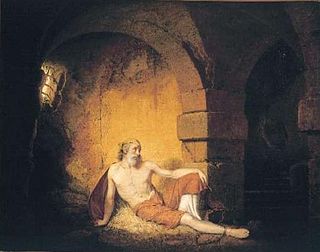 W
WThe Captive, from Sterne is a painting by Joseph Wright of Derby completed in 1774 and now in the National Gallery of Canada. Sterne's Captive, first exhibited by the artist in 1778, is a similar painting by Wright in the Derby Museum and Art Gallery. The latter painting resulted in a rare engraving, as its purchaser commissioned a print run of only twenty copies before the copper printing plate was destroyed. In 2012, Derby Museum commissioned another Captive painting from Emma Tooth.
 W
WThe Captive King is a sketch by Joseph Wright of Derby completed in 1772 or 1773. It depicts the French nobleman Guy de Lusignan held prisoner by Saladin. The sketch is thought to have been a preparation for the now-lost painting Guy de Lusignan in Prison.
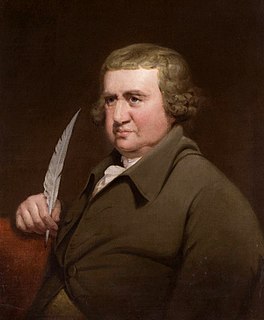 W
WErasmus Darwin was an English physician. One of the key thinkers of the Midlands Enlightenment, he was also a natural philosopher, physiologist, slave-trade abolitionist, inventor and poet.
 W
WDovedale by Moonlight, 1784, is one of five paintings by Joseph Wright of Derby which uses the picturesque valley of Dovedale as its subject. These paintings were sometimes made as pairs with one showing the view by day and the other by moonlight. Wright admitted that he had not observed this scene directly, "Moon lights & fire lights are but a sort of work with me for I cant with impunity go out at night and study the former, & the latter I have seen but once, and at a time too, when I thought not of painting such effects."
 W
WEarthstopper on the Banks of the Derwent is a painting by Joseph Wright of Derby originally completed in 1773. The scene shows a man digging at nighttime beside the River Derwent in Derbyshire.
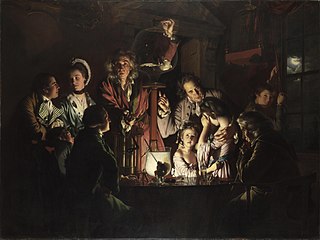 W
WAn Experiment on a Bird in the Air Pump is a 1768 oil-on-canvas painting by Joseph Wright of Derby, one of a number of candlelit scenes that Wright painted during the 1760s. The painting departed from convention of the time by depicting a scientific subject in the reverential manner formerly reserved for scenes of historical or religious significance. Wright was intimately involved in depicting the Industrial Revolution and the scientific advances of the Enlightenment. While his paintings were recognized as exceptional by his contemporaries, his provincial status and choice of subjects meant the style was never widely imitated. The picture has been owned by the National Gallery in London since 1863 and is regarded as a masterpiece of British art.
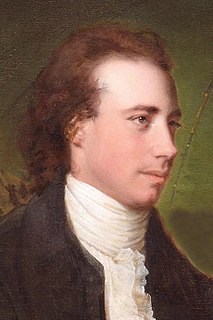 W
WThomas Gisborne was an English Anglican priest and poet. He was a member of the Clapham Sect, who fought for the abolition of the slave trade in England.
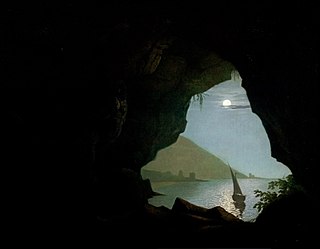 W
WGrotto in the Gulf of Salerno is the subject of at least four paintings completed by Joseph Wright of Derby following his visit there in 1774. The paintings show the different lighting at different times of the day.
 W
WIndian Widow is a painting by Joseph Wright of Derby, completed in late 1783 or early 1784 and first shown in his solo exhibition in London in 1785. The painting is now in a private collection owned by Dr. Christine I. Oaklander.
 W
WMiravan Breaking Open the Tomb of his Ancestors is a painting by Joseph Wright of Derby originally completed in 1772.
 W
WFrancis Noel Clarke Mundy was an English poet. His most noted work was written to defend Needwood Forest which was enclosed at the beginning of the 19th century. He was the father of Francis Mundy.
 W
WNeedwood Forest was a large area of ancient woodland in Staffordshire which was largely lost at the end of the 18th century.
 W
WHarry Peckham was a King's Counsel, judge and sportsman who toured Europe and wrote a series of letters which are still being published over 200 years later. Peckham was a member of the committee that drew up early laws of cricket including the first inclusion of the leg before wicket (lbw) rule. The diarist James Woodforde makes reference to Peckham playing cricket at Oxford in 1760. and he was still playing in 1771.
 W
WA Philosopher by lamplight is a painting by Joseph Wright of Derby. It is not known when Wright painted the picture, but it was first exhibited in 1769 in London with the Society of Artists. This was one of the earliest of many lamplight or candlelight paintings and portraits for which Wright is famed.
 W
WA Philosopher Lecturing on the Orrery, or the full title, A Philosopher giving that Lecture on the Orrery in which a lamp is put in place of the Sun, is a 1766 painting by Joseph Wright of Derby depicting a lecturer giving a demonstration of an orrery — a mechanical model of the solar system — to a small audience. It is now in the Derby Museum and Art Gallery The painting preceded his similar An Experiment on a Bird in the Air Pump.
 W
WRomeo and Juliet: the Tomb Scene is a painting by Joseph Wright of Derby, completed by 1790, exhibited in 1790 and 1791, shown in the Derby Exhibition of 1839 in the Mechanics' Institute, and now displayed in Derby Museum and Art Gallery. The painting exhibits Wright's famed skill with nocturnal and candlelit scenes. It depicts the moment in Shakespeare's Romeo and Juliet when Juliet, kneeling beside Romeo's body, hears a footstep and draws a dagger to kill herself. The line is "Yea, noise? Then I'll be brief. O happy dagger!"
 W
WThree Persons Viewing the Gladiator by Candlelight is a 1765 painting by Joseph Wright of Derby and now resides in a private collection in the United Kingdom. It depicts three men examining a reproduction of the Borghese Gladiator, a famous Hellenistic statue discovered in Italy. The painting was one of the first in Wright of Derby's "Candlelight Pictures" series and was originally exhibited in London, gaining much attention. Four years later a mezzotint of it was made by William Pether.
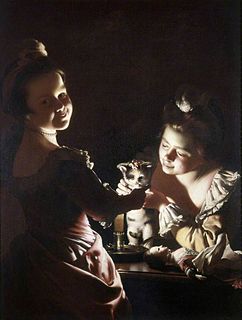 W
WTwo Girls Dressing a Kitten by Candlelight is a "fancy painting" by Joseph Wright of Derby (1734–1797). The painting is currently on display at the Kenwood House Public Museum, located in the London Hampstead area.
 W
WVesuvius from Posillipo by Moonlight was painted by Joseph Wright of Derby in 1774. It is an oil painting of Mount Vesuvius in the distance, from the coastal shores of Naples at night. Dark grey smoke spews from the glowing red crater of the volcano and fills up the top right of the canvas, in contrast to the pale glow of moonlight to the left. Known as a "Painter of Light," Wright liked to play with highlights and shadows in his works and was most well known for his "Candlelight Pictures," landscape or genre scenes depicting dramatic contrasts between light and dark. Through utilizing this technique, Joseph Wright exhibits the sublimity of nature in Vesuvius from Posillipo by Moonlight as well as his other paintings of Mt. Vesuvius.
 W
WVesuvius in Eruption is the subject of a series of thirty paintings and at least one preliminary sketch by Joseph Wright of Derby, who travelled in Italy in the years 1773-1775. It appears that whilst Wright was in Italy Vesuvius was not erupting.
 W
WVirgil's Tomb is the title of at least three paintings completed by Joseph Wright of Derby between 1779 and 1785.
 W
WJoseph Wright, styled Joseph Wright of Derby, was an English landscape and portrait painter. He has been acclaimed as "the first professional painter to express the spirit of the Industrial Revolution".